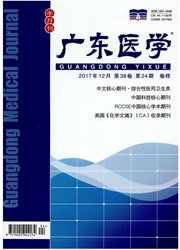

 中文摘要:
中文摘要:
目的 探讨格列吡嗪对小鼠结直肠癌肝转移的作用及机制。方法 对BALB/C小鼠注射CT26细胞建立结直肠癌肝转移模型,建模后小鼠随机分为对照组15只和实验组14只,对照组和实验组术后隔天分别腹腔注射生理盐水和格列吡嗪,18 d后称量肝脏重量,计数肿瘤数量,利用免疫组化进行Ki67和CD31染色,观察肿瘤的增殖和血管形成情况。提取肿瘤组织RNA,进行qPCR-array实验,筛选格列吡嗪作用的靶点。结果 实验组小鼠肝脏重量和肝转移肿瘤数目均明显低于对照组(P〈0.05),且肿瘤微血管密度和肿瘤的增殖率也明显低于对照组(P〈0.05),qPCR-array筛选出格列吡嗪的作用靶点为血管内皮生长因子(VEGF)。结论 格列吡嗪可以通过抑制VEGF的表达抑制肿瘤的增殖和血管新生,从而抑制肿瘤细胞的迁移,进而抑制小鼠结直肠癌肝转移的发生、发展。
 英文摘要:
英文摘要:
Objective To investigate the effect of glipizide on liver metastasis of colorectal cancer and its mecha- nism. Methods 32 BAL/C mice injected with CT26 cells were used to establish the model of liver metastasis from color- ectal cancer. Model mice were randomly divivded into the control group (n = 15 ) and the experimental group( n = 14). The control group was intraperitoneally injected with normal saline and the experimental group was intraperitoneally injec- ted with glipizide. The surface number of liver metastasis and liver weight were analyzied, and immunohistochemical stai- ning of Ki67 and CD31 was used to analyze the cancer cell proliferation and angiogenesis. Tumor RNA was extracted and detected by qPCR - array experiment to screen for glipizide targets. Results Liver weight, liver metastasis numbers, tumor microvessel density and proliferation rate of the experimental group were significantly lower than those of the control group, qPCR - array screening showed that the glipizide target was VEGF. Conclusion Glipizid inhibits liver metastasis of colorcetal cancer through VEGF suppressing angiogenesis and tumor cell proliferation.
 同期刊论文项目
同期刊论文项目
 同项目期刊论文
同项目期刊论文
 期刊信息
期刊信息
